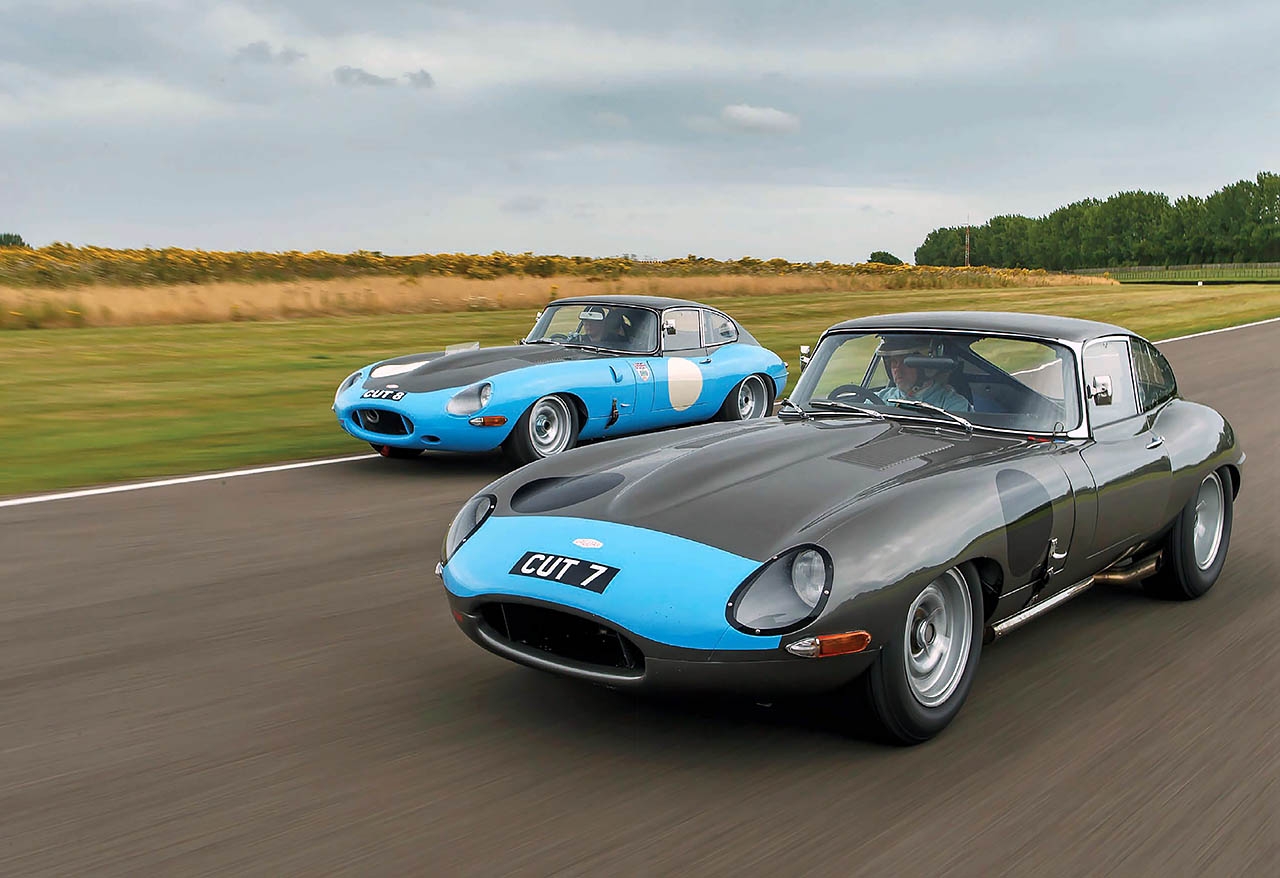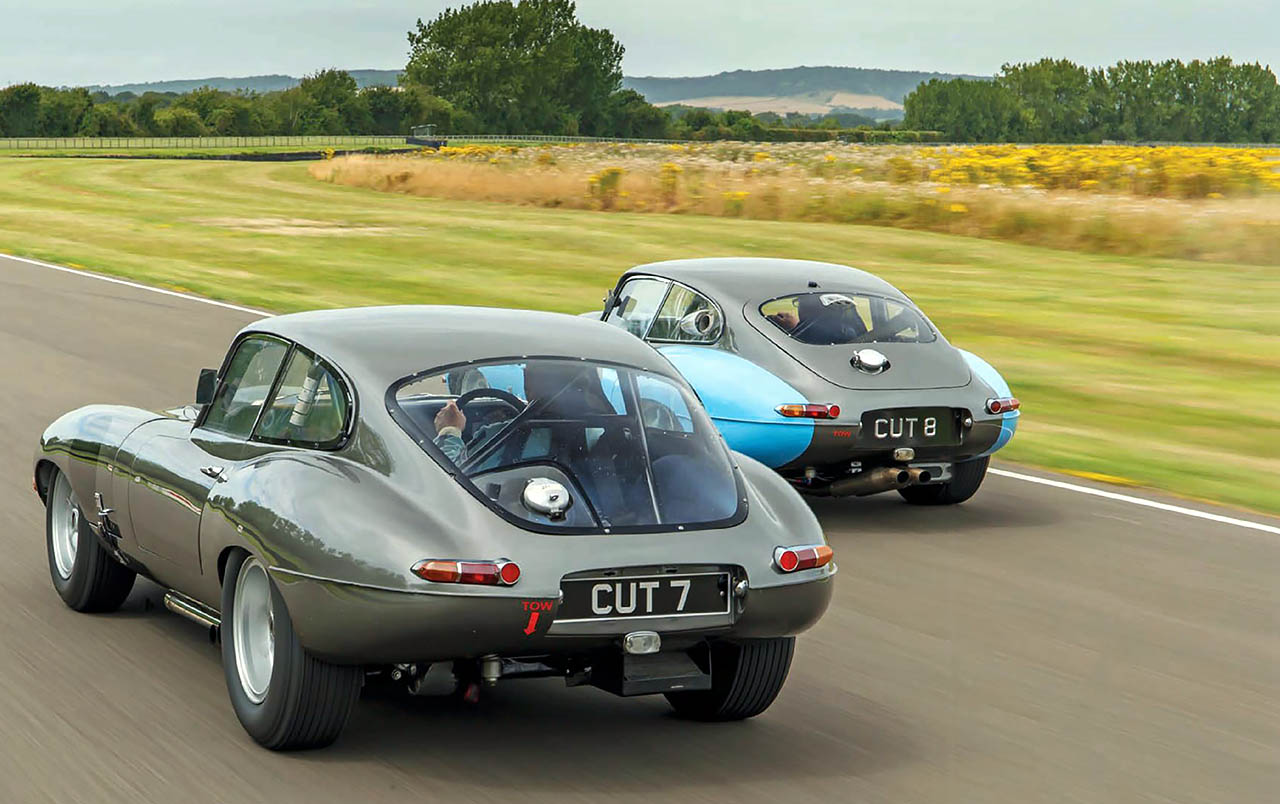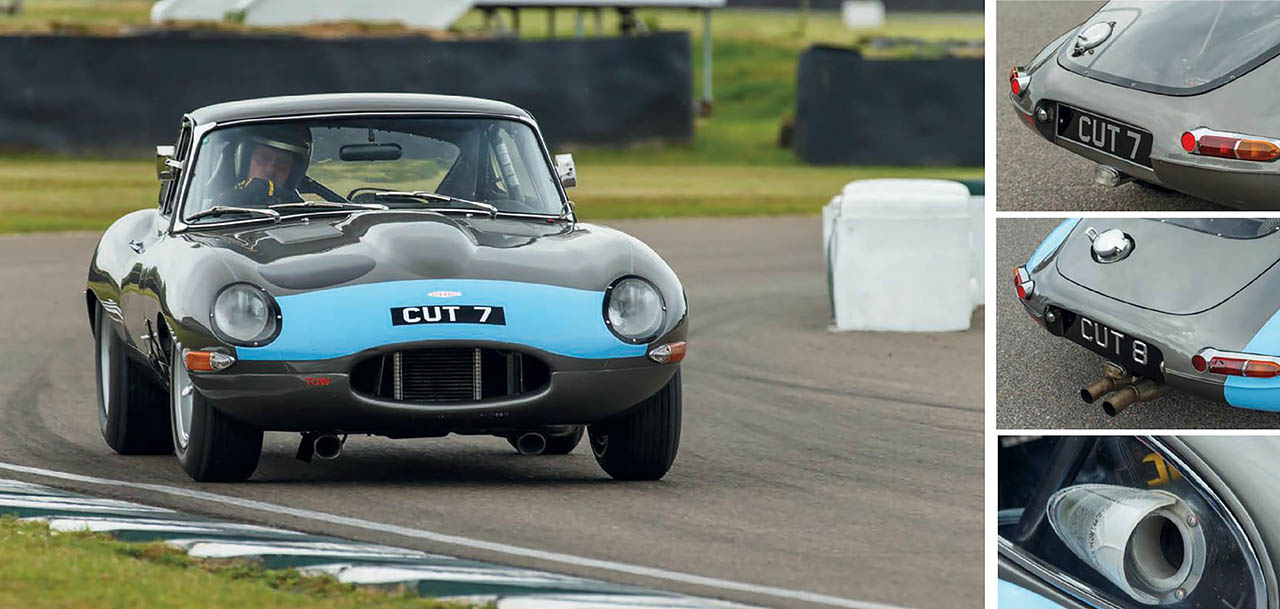
Exclusive: Jaguar Legends. Reunited Protheroe’s E-types. Reuniting famous CUT 7 and 8 racers. Julian Balme tells the story of Dick Protheroe and his famous Jaguars. Making the cut. Dick Protheroe led a remarkable life, even before his series of racing E-types. Julian Balme tells the story behind one of motorsport’s most famous numberplates. Photography David Shepherd/LAT.
The casual observer of last year’s TT Celebration race at the Goodwood Revival could be forgiven for being both puzzled and intrigued by the presence of not one, but two fixed-head E-type coupés. Both wore deep metallic grey paint with blue embellishments and registration plates starting with the letters CUT, followed by 7 in one case and 8 in the other. They are associated and connected with one remarkable man, Dick Protheroe – yet, in the case of his E-type Jaguars, they are literally only half the story. In total, there were four examples linked to this charismatic Leicestershire garage owner who was based at Husbands Bosworth. The two seen at Goodwood, and featured here, were the first and the last of those.

Protheroe had already lived several enviable lives before Jaguar launched the E-type, both on the track and in the air. Born Elmer Richard Protheroe in 1922, Dick joined the RAF at the outbreak of WW2, flying Wellingtons and Lancasters for Bomber Command – ultimately being awarded the Distinguished Flying Cross for his courage and fortitude. Following the war, he completed operational tours with the Pathfinder Force No 7 squadron, seconded to BOAC, and flew in the Berlin Airlift.
Although he was growing increasingly interested in racing cars, the RAF was in no hurry to dispense with his services. At the beginning of the 1950s, he was deployed as a test pilot in the development of the V bombers, notably the Valiant and Victor, along with the Meteor fighter before going on to train air crews. He was still flying when he lost his right eye during a stockcar race, when a stone was thrown up by a car he was pursuing. Despite this, and to his frustration, he wasn’t pensioned out, though he was no longer allowed to fly in formation.
It was while Protheroe was stationed in Egypt during 1952 that he acquired his first Jaguar – an aluminium-bodied XK120 that he modified and successfully raced with local motor clubs. Having supposedly found the car by the Pyramids, he jokingly referred to it as an ‘Ancient Egyptian’; the nickname soon passed into motor-racing mythology. In 1953, he returned with the car to England and registered it GPN 635. It would be the first of three XKs he owned, the final one being registered CUT 6.
By the time Protheroe was racing that last, much-modified 120, he was finally no longer in the RAF and, to pursue his primary interest, had started a small Austin dealership called County Motors. Aided by a young apprentice mechanic, Bill Cotterill, the small race team proved fiercely competitive, including a season (1958) with an Austin-Healey 100S – his sole non-Jaguarpowered entry during a 10-year period of regular competition. Protheroe was a staunch Jag man, probably out of loyalty to his friend Sir William Lyons and, inevitably, as his business entered the 1960s, it expanded to accommodate the servicing and sales of the new E-type.
The first of the right-hand-drive thoroughbreds to be released from Coventry were all roadsters. Several, headed by the cars of John Coombs, Tommy Sopwith, Peter Sargent, Robin Sturgess and Jack Lambert, were immediately pressed into service on the racetrack. It wasn’t until late August and into early September that the first of the right-hand-drive fixed-heads came on stream, the fourth – chassis number 860004 – being allocated to Protheroe.
Finished in Opalescent Gunmetal Grey with dark blue interior trim, it was dispatched to him on 13 September 1961. According to Pat Wells, then an apprentice at the garage, it was following a particularly exhausting race at Silverstone in the XK against the new E-types that Protheroe admitted to not being able to compete at that pace. He therefore took the decision to turn his new road car into a racer for the 1962 season.
He drove it extensively, not just in club events but at international level, though his quest in that first season was to secure the Autosport National Championship for Production Sports Cars. With just one retirement in 10 outings (due to a broken throttle cable), he took victory in the Over 3-litre category.
For a privateer in a self-prepared car, Protheroe’s results were outstanding in that debut year – six firsts, a second and five thirds being just his podium finishes. He was as good behind the wheel as any of his contemporaries, but what set him apart was his engineering background and subsequent analysis. Wells recalls that after each race he would log everything about the way the car had behaved in much the same way he had done when testing for the RAF: “Dick would actually calculate [brake] pad wear. He was quite meticulous and very set in his ways. You did things his way or no way at all.”
Protheroe developed the car in the methodical way one might expect from an aviator and, using his influence at the nearby military base at Bruntingthorpe, was often seen testing on the runway. Registered CUT 7, the Jaguar received an additional pale blue flash across its nose in what was thought to be a reference to one of his first race cars – a much-loved Type 37 Bugatti acquired in 1947, in which he finished second in a handicap race at Gransden Lodge.
Despite other season high points, such as a sixth-placed finish against formidable opposition at Goodwood in the RAC Tourist Trophy, it was clear that CUT 7 was too heavy and compromised, being little more than a modified road car. At the end of the year, it was registered 636 CJU and returned to fast-road trim to make way for a new CUT 7. Another of the Protheroe garage staff, Tony Ward, had been given the task of ordering and collating from Browns Lane enough parts to make a completely new racer. In that way, lightness could be built into its construction, along with countless other modifications that had been gleaned from 15 races with the previous E-type.
Hopes were high for the new home-built car, which was given its own chassis number – DP138D5 – but on its very first outing at Snetterton in March 1963, Protheroe managed to roll the car three times during a flash thunderstorm. It was rebuilt within 10 days, but his faith in the E-type had already been shaken. After five more races, it was registered 256 DJU and sold to local hotshoe Roger Mac.
In the June, Protheroe visited the Jaguar Competition Department with the aim of obtaining a Lightweight E-type. On being told that production had stopped, he saw the experimental, one-off, factory low-drag coupé gathering dust in the corner and went home with that instead. Norman Dewis apparently once told Wells and Ward that they should have given the car to Dick a year earlier because he would have done a much better job developing it.
As it was, the garage proprietor didn’t do badly in the time he had it. He immediately enjoyed success in a sports car fixture at Reims, finishing second overall and winning the GT class ahead of the Ferrari GTOs. Protheroe nearly didn’t make that race because he realised only on nearing London that he’d left his passport at home. Rather than miss the ferry, he unloaded the Jaguar from its trailer, sent the crew on ahead to the port and blasted back to Leicestershire to pick up the missing paperwork. He then raced south again to rejoin his team.
Despite its alloy-block engine, it was still heavy and initially there were fuel-injection issues. One tale has Protheroe complaining about the fuelling of the engine while practising at Goodwood. After a quick phone call to Browns Lane, he drove the low-drag to Coventry, had the injectors inspected and cleaned, and then returned to the Sussex track. He would finish sixth again in the Tourist Trophy with the unique E-type, by then registered CUT 7.
For the 1964 season, he enlisted John Coundley as a co-driver. Together they contested a number of high-profile European races at circuits such as the Nürburgring and Spa, also winning their class in both the Reims 12 Hours and the Paris 1000km. During the year, Protheroe had the flanks of the silver-grey car painted pale blue, the distinctive scheme wrapping around the nose and along the wings to the rear of the Jaguar. It wouldn’t be the last ‘Protheroe E’ to be painted in such a way.
The low-drag was sold at the beginning of 1965 – today it resides in the USA – and Protheroe’s racing was limited to a few outings with Mike Salmon in the Maranello Concessionaires 250LM. Presumably inspired by the experience, he finally tore himself away from Browns Lane, acquired a Ferrari 330P and entered the 1966 Tourist Trophy at Oulton Park. Late during untimed Thursday practice on 28 April, he crashed fatally at Druids Corner.
His then (and second) wife, Rosemary – formerly Massey, of the famous tractor-making family – inherited the business on being widowed. They’d met at the race track and, by way of a tribute to her late husband, she had the mechanics acquire and build up another competition E-type. The car, chassis number 860953, was known to the garage because they had sold it to, and prepared it for, the first owner, Ed Nelson. Once it had been bought back, the British Racing Green fixed-head was resprayed grey with blue – as per the low-drag – fitted with a 4.2-litre dry-sump powerplant and registered CUT 8. Both Rhoddy Harvey Bailey and Ed Nelson successfully campaigned it on Rosemary’s behalf in national marque races for nearly two years before she became ill. The car was sold at the end of the 1968 season.
During his 44 years, Dick Protheroe carved an enviable path through life. On a modest budget and using what was acknowledged as the lesscompetitive ‘spec’ car, he played an extraordinary role in Jaguar’s competition history. Were he to have got his hands on a factory Lightweight, perhaps his contribution to E-type lore would have been even greater. As Pat Wells recalls: “He was like Blackpool rock – he had the word ‘Jaguar’ running through him from top to bottom. I remember one day I’d bought a couple of Ferrari stickers and put them on my toolbox. He noticed them and said: ‘You can take those bloody things off.’ Seems all the more cruel that he should have lost his life in one.”
Thanks to Richard Meins; Gregor Fisken
‘ON A MODEST BUDGET, PROTHEROE PLAYED AN EXTRAORDINARY ROLE IN JAGUAR HISTORY’

CUT 8 locked in battle with Big Healey at Crystal Palace. The first CUT 7, on the Silverstone Club circuit in 1962. Protheroe’s shortlived second CUT 7 at Silverstone, 1963. Last of the line: the lowdrag at the 1963 Tourist Trophy. Clockwise: CUT pairing together at Goodwood – both are still raced; modern wheel in CUT 7’s stripped cockpit; early chassis number; triple Webers for XK engine. Inset: Dick Protheroe pictured in the mid’ 60s.

Clockwise: both cars are now back in Protheroe livery; CUT 8’s 4.2-litre powerplant; chassis plate; near-standard interior even boasts passenger seat; CUT 8 is now expertly campaigned by Gregor Fisken.
Post-Protheroe
THE FIRST CUT 7: CHASSIS 860004
Having been re-registered 636 CJU, the production fixed-head was sold as a road car in early 1963 to a Mr Clive Castle. Mike Moore acquired it in the late ’60s to tow his Clubmans racer, before Ted Walker became the next owner in ’73 – by which time it had a sunroof and radio. A decade later it was in the hands of John Young, who occasionally raced it. On a tip from Gerry Marshall, the car was bought at auction by Colin Pearcy, who had it restored to ‘Protheroe spec’ and campaigned it in historics. For the past 20 years, it has often been seen in the hands of Pearcy then Nick Whale, Lord Drayson and current owner Richard Meins.
THE SECOND CUT 7: CHASSIS DP138D5
Although never actually registered as such, according to mechanic Pat Wells, CUT 7 number two had a tough life following its sale in mid-1963. Roger Mac registered it 256 DJU and enjoyed success that season before it passed on to David Cunningham. By 1965/’66, it was with Richard Ward and Paul Vestey, who entered more than 20 races with it until a massive crash at Silverstone. Many of its mechanical parts were picked up by John Lewis, who fitted them to a roadster and registered it SVJ 345. He raced it in Modsports before converting it to a more period specification. He has now acquired the remains of the original fixedhead shell from Penny Woodley.
THE THIRD CUT 7: CHASSIS EC1001
Advertised in early 1965 for £3200, the low-drag was sold to David Wansborough, who infamously launched it into Oulton Park’s lake. It had become 738 EUT by the time it passed to Mike Wright in 1968, and later became part of the Walter Hill collection in Florida, before returning to the UK c1990 via Paul Vestey. In ’94, it was sold to David Pennell before moving on to Lord Cowdray, who secured the official CUT 7 registration. Following a number of Revival outings, EC1001 now resides in the USA.
CUT 8: CHASSIS NUMBER 860953
CUT 8 was re-registered 105 ENX in 1970 and raced by Peter Walker. After being moved on at the end of ’73 by Brian Classic, the trail goes cold until 1988 when John Lewis (he of the second CUT 7) uncovered the car. In 1991, it was formally registered as CUT 8 once more and has been raced in historics ever since. It was acquired by Gregor Fisken four years ago.

Balme presses on through Goodwood’s chicane, following in Protheroe’s wheeltracks. Below, from top: two well-known plates – note CUT 7’s larger Perspex rear screen and 8’s dual exhausts; air vent on CUT 8.
WPD vs CUT
Gregor Fisken has been fortunate to campaign several significant racing E-types, including the ex-Coombs Lightweight 4 WPD and more recently CUT 8: “In terms of feel, the cars [factory Lightweight and fixed-head coupé] handle quite differently.
The Lightweight’s aluminium monocoque makes it more agile, more responsive – as you’d expect. But these days, with the cars running lower, they don’t respond to suspension stiffening in the way the steel one does. We did develop 4 WPD a bit but were ultimately limited by the amount of body flex and never felt we had it as stiff as we’d like. With CUT 8, we had an inherently much more stable platform to build upon and were able to use softer springs.
“Where the aluminium car beats the fixed-head, of course, is in its weight. At Goodwood, I could get just as clean a corner exit – maybe even better – but hauling that extra weight [250kg] out of the corner you could feel the difference as you dropped off the back of the Lightweights.
“At high speed, the larger frontal area of the fixed-head counts against it, too. I think aerodynamically, the roadster with the hardtop is a cleaner shape – something Jaguar also felt and pursued. It explains why they came up with the low-drag.”
‘PROTHEROE WAS A STAUNCH JAG MAN, PROBABLY OUT OF LOYALTY TO HIS FRIEND SIR WILLIAM LYONS’





